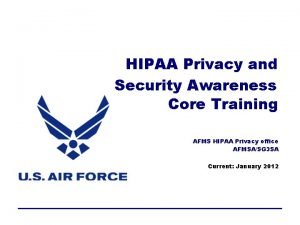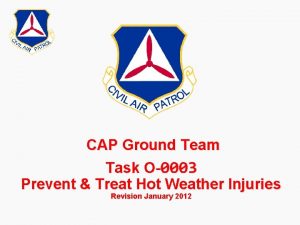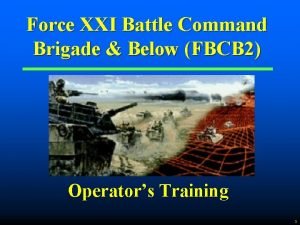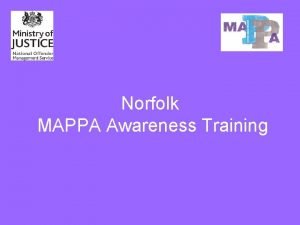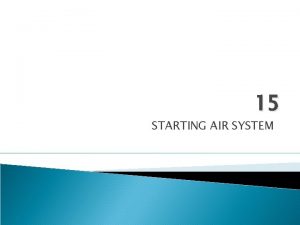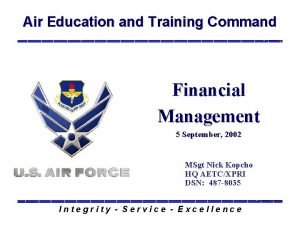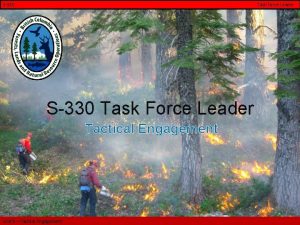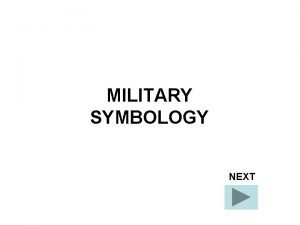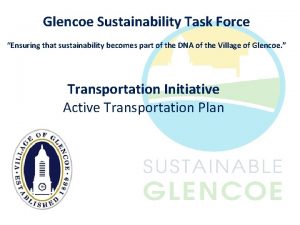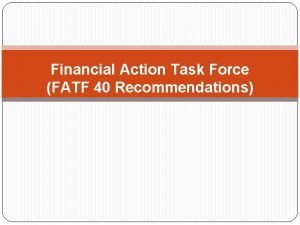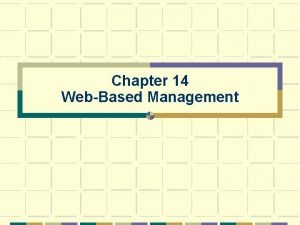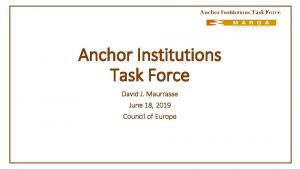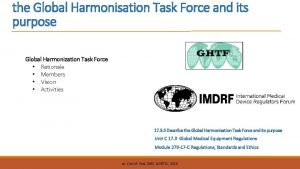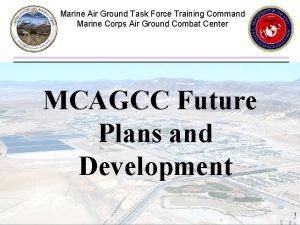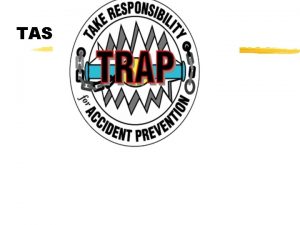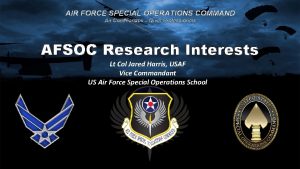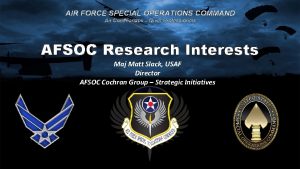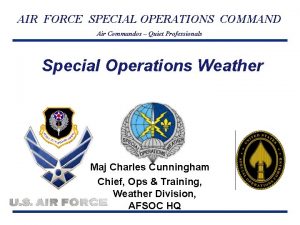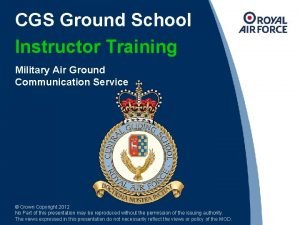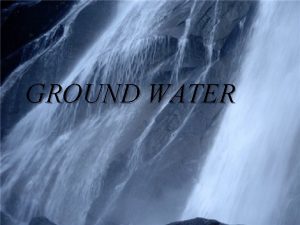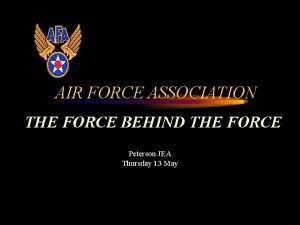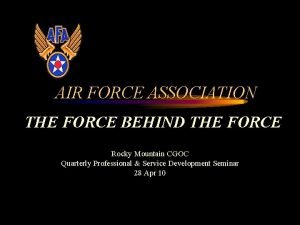Marine Air Ground Task Force Training Command Marine





















- Slides: 21

Marine Air Ground Task Force Training Command/ Marine Corps Air Ground Combat Center Twentynine Palms, CA

America’s 911 Force “As the Nation’s crisis response force and force in readiness, Marines remain forward deployed, ready to fight and win tonight. As Marines have always done, we will continue to seek new opportunities and develop solutions that maintain an overwhelming tactical advantage over any adversary. “ - General Robert B. Neller, 37 th Commandant of the Marine Corps

Marine Corps Overview Personnel: Ø Active Duty Component: ~184, 200 Ø Marine Corps Reserve: ~39, 600 Ø Currently Deployed: ~30, 100 USMC receives ONLY 7% of the DOD Budget and Contributes: Ø Ø 21 % Infantry Battalions 15% Fighter/Attack Aircraft 11 Artillery Batteries 7 Scalable MEUs deployed on amphibious ships worldwide UNCLASSIFIED//FOUO

The Combat Center Twentynine Palms, CA UNCLASSIFIED//FOUO

Dual Mission of the Combat Center • Marine Air Ground Task Force Training Command (MAGTFTC): Manage the Marine Air Ground Task Force Training Program (MAGTFTP) and conduct service level Marine Air Ground Task Force (MAGTF) combined arms training to enhance the combat readiness of the operating forces and support the Marine Corps’ responsibilities to national security. • Marine Corps Air Ground Combat Center (MCAGCC): Provide a standard of excellence in managing facilities, services and support to the operating forces, and families in order to ensure readiness of the tenant and resident commands aboard the Combat Center. 5

Operational Requirements • Marines deploy as a Marine Air Ground Task Force (MAGTF). • MAGTF has a single commander with ground, air and logistics components. • Structured to accomplish specific missions/Mission dictates size of force assembled. • USMC determination – Marine Expeditionary Brigade (MEB) MAGTF is the essential size to meet global challenges. • Marines MUST train as we fight.

Land Expansion Project • USMC Requirement: Provide sustained, combined-arms live-fire, and maneuver field • Expansion: Existing facilities, ranges and live-fire ground air maneuver areas are training for Marine Expeditionary Brigade (MEB) sized Marine Air Ground Task Forces (MAGTFs). inadequate to support the requirement for MEB-sized training exercises. • 2006: Universal Needs Statement Approved for Large-Scale MAGTF Training area at MCAGCC • 2007 -2013: USMC completed NEPA process • 2013: MCAGCC expanded and Johnson Valley Shared Use Area Established • 2016: First Large Scale Exercise completed

NDAA Disposition of Lands • • Total: 163, 980 acres West Study Area: 144, 540 acres Exclusive Use: 88, 130 acres Shared Use: 56, 410 acres South Study Area: 19, 440 acres Shared Use Area: Non-dud producing LF only Establish RMG to coordinate

LSE-17 Elements and Activities LSE-17 included: long-range raids, casualty evacuations, live-fire events, defensive operations, cyber and electronic warfare, information operations, and close-air support • Command Element: 2 nd Marine Division • Ground Combat Element: • • 2 nd Mar. Div Regimental Combat Team-8 5 th Mechanized Brigade Group, Canada 3 rd Command Brigade, UK 6 th Light Armoured Brigade, France • Air Combat Element: 2 nd Marine Aircraft Wing • Logistics Element: 2 nd Marine Logistics Group • II Marine Expeditionary Force Information Group

LSE-17 Video

TSUA to Support Land Expansion • The process to complete acquisition of additional Permanent SUA could take several years to complete. In the interim, the Marine Corps successfully pursued temporary measures to accommodate Large Scale Exercise-17 through a Temporary Special Use Airspace Proposal. • TSUA was necessary to safely utilize the airspace to support training over the newly acquired lands.

TSUA Effort and Beyond • LSE-17 TSUA will serve as a “Proof of Concept” for Permanent new SUA proposal. • Permanent SUA is to support both MEB and MEB building block exercises. • FAA process towards Permanent SUA solution is 2 -5 years. July 2016 – FAA formally disapproved Marine Corps TSUA proposal for LSE-16. July 2016 August 2016 LSE-16 executed (convoy ops) Aug 2016 October 2016 – Marine Corps submitted TSUA proposal in support of LSE-17. FAA approves TSUA LSE-17 26 Jun 2017 processing time: ~280 days LSE-17 (Combined Arms Training ) Summer 2017 – Incorporate lessons learned from LSE-17 to evaluate for adjustments to Permanent SUA proposal. Fall 2017 – Marine Corps to submit anew a Permanent SUA Proposal in support of future MEB and MEB Building Block Exercises. LSE-18 (MEB-level training) Sept 2016 Oct 2016 Nov 2016 July 2017 Aug 2017 Summer 2017 Fall 2017 Summer 2018

TSUA Approval - TSUA approved by FAA for LSE-17, 29 June 2017. - TSUA for LSE-17 is a subset of the required SUA to fully support a LSE/MEB training at MCAGCC with new JV lands. - Coordination for the TSUA for LSE-17 to support live fire and maneuver training will occur daily between LA Center (FAA) and MCAGCC.

FAA Key Events • April 2012: CG MCIWEST and MCIWest / MCAGCC/ TECOM staff brief updated PSUA proposal to FAA Los Angeles Center (ZLA) – reduced airspace proposal from that assessed in project EIS. • February 2014: MCIWest /Western Regional Airspace Coordinator (WRAC) brief ZLA on further revised (reduced) PSUA proposal. • April 2014: MCAGCC submits PSUA proposal to FAA Western Service Area Headquarter (WSA). • • September 2015: TSUA LSE-16 proposal submitted to WSA. • • • July 2016: WSA formally disapproves TSUA LSE-16. November 2015: WSA reply regarding PSUA: “we cannot support… open dialogue to reach a viable solution. ” October 2016: TSUA LSE-17 proposal submitted to WSA. June 2017: FAA approves LSE-17 TSUA.

Special Use Airspace and So. Cal Air Traffic Flow

PSUA Way Ahead • Marine Corps review LSE-17 for lessons learned operating under TSUA. • Marine Corps review original PSUA proposal and, if determined necessary, amend proposal to meet SUA requirements to support MEB sustained, combined-arms livefire maneuver training. • Marine Corps leadership (three-star, AVN, MCCDC, I&L) approve PSUA submission. • Marine Corps, with NAVAIR, submit PSUA proposal to FAA.

PSUA Proposal 29 Palms Proposed Permanent Special Use Airspace • Surface to FL 400 • • • 40 days /year supporting two x 20 -day Exercise • Proposals delivered to the FAA Regional HQ • New Bristol MOA/ATCAA New CAX MOA Corridor /ATC AA • Two x 3 -day FINEXs, Two x 17 -day Exercise Work Ups • R-XXXX A/B/C/D Johnson Valley MOA/ATCAA New Turtle A/B/C MOA/ATCAA • • • New Sundance MOA/ATCAA • • R-XXXX A/B/C/D R-XXXX A & D: SFC-FL 400 R-XXXX B & C: SFC-8000 ft Johnson Valley MOA/ATCAA: 3000 ft – FL 400 New Sundance MOA/ATCAA: 1500 ft – FL 400 New Bristol MOA/ATCAA: 1500 ft – FL 400 New CAX Corridor MOA/ATCAA: • CAX LOW 1500 ft – 8000 ft • CAX HIGH FL 180 –FL 400 New Turtle MOA/ATCAA New Turtle A MOA/ATCAA: 11, 000 ft – FL 220 New Turtle B MOA/ATCAA: FL 220 – FL 400 New Turtle C MOA/ATCAA: 1500 ft – 11, 000 ft

Local Outreach to Land Airspace Stakeholders • • Within 100 miles of MCAGCC East to Arizona North to Nevada West to Edwards AFB South to NAS El Centro area Southeast to MCAS Yuma Southwest to San Diego and Riverside area

Outreach Approach • Stakeholder Engagement – Regional airports – General Aviation groups/associations • • Communication with airport authorities SUA briefings to General Aviation groups/associations – – • • • Experimental Aircraft Association (EAA) Aircraft Owners and Pilots Association (AOPA) National Business Aviation Association (NBAA) Mid-air Collision Workshops (Host) Social media/Website/App Product distribution Stakeholder e-mail Blast

Temporary Special Use Airspace Outreach LSE-17 • • Email Blast Recipients – 37, 000+ Products Published and Distributed – 10, 000+ • • NOTAM Poster Quick Pilot Reference Card SUA Brochure SUA Flyer Briefs – 28 Visits – 50 + Conferences – 2 Articles Published – 2 Unprecedented TSUA Establishment and Charting over MCAGCC

Questions / Discussion
 Hubungan air dengan tanah
Hubungan air dengan tanah Hipaa training air force
Hipaa training air force Ground team task guide
Ground team task guide Tiered task bias task
Tiered task bias task Eplrs
Eplrs 7 golden rules of information sharing
7 golden rules of information sharing Training ground rules
Training ground rules Air starting system in marine diesel engine
Air starting system in marine diesel engine Naval service training command
Naval service training command Command financial management system training
Command financial management system training Nwcg s-330
Nwcg s-330 Expected armored cavalry troop symbol
Expected armored cavalry troop symbol Glencoe sustainability task force
Glencoe sustainability task force R.e.a.c.t. task force
R.e.a.c.t. task force Iowa food protection task force
Iowa food protection task force Fatf40
Fatf40 Green ribbon task force
Green ribbon task force Princeton policy task force
Princeton policy task force Desktop management task force
Desktop management task force Anchor institutions task force
Anchor institutions task force Global harmonisation task force
Global harmonisation task force Social performance task force
Social performance task force

